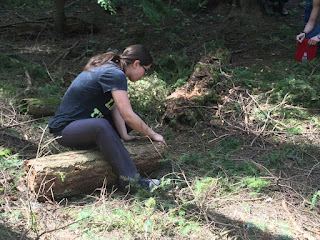April 18th, we had a class field trip to Pine Ridge Park in Lynnwood. There, we met with our fungus loving guide Korena. With her powerful orator voice, she explained the 3 different types of fungi we were to see. First, Saprophytic, which would be the decomposers. Then the mycorrhizal, which are extensions of the root systems of the fungi, they are probably the trees’ best friends. And the third type of of fungi is the pathogenic fungi, which cause all sorts of disease and are not as good friends of the forest.
One of the first things Korena pointed out was a black path on a tree along the trail. she mentioned that the tree is sick with a pathogenic fungi. This particular fungi eats the bark of the tree, weakening the tree. Thats why during a windstorm, the tree breaks at the root. In most cases, the tree will release sap to try to flush out the fungus.
On the same tree, right above the black patch, Korena pointed out some lichen. There are over 20,000 lichens! They are composed of a fungi and an algae, together they live in a mutualistic relationship in which the algae, being a heterotroph, synthesizes sugars for the fungi. We saw powder lichen and crust lichen. She explained that lichen on trees is an indicator for the trees age. Growing at rate of about a centimeter a year, the more lichen the tree has, the older the tree.
Crusty lichen is shown below:
Making our way down the trail, we saw many logs and branches scattered around. Turning one over, Korena pointed out conks. A conk is fruiting body of a wood rotting fungus. It is a decomposer with a very tough body. They are able to produce an enzyme capable of breaking down the tough lignin that surrounds the cellulose in the tree. This provides access to the cellulose underneath the lignin.
A few fruiting bodies of the conks shown below.
Further down the trail, we stopped by some bushes. After examining it for a minute or two, Korena pointed out leaf blight. Leave blight is a very destructive disease. The fungus essentially eats away at the leaves. Leaves first becoming spotted, then brown and then they drop off.
About the same time, Korena pointed out mosses. Pretty much everywhere we looked, we saw moss. Under bushes, next to trees, covering most of the ground. Mosses are non-vascular plants which grow on hosts.
Finally, the most exciting part, we saw some mushrooms! Korena explained that the “mushroom” we see, is just the fruiting body. Most of the body is underground in structures called mycelium. The biggest mycelium network so far discovered is in Oregon stretching some 2.5 thousand acres! This network can be underneath the whole forest and a tragedy on one side of the forest can very well be seen through this network on the other side.
We then found 2 mushrooms, both Amanita, from phylum Basidiomycota. The first that Korena found, she mentioned that there were maggots inside and was rotting on the inside.
We found another one, and in Korenas scientific description, it was “perfect”.
Korena explained that this mushroom is from the same genus as the death cap and did not recommend tasting it, although who would want to (Nate). These mushrooms have a mutualistic relationships with trees. The trees are stationary and can’t “scavenge” for some nutrients. Mushrooms can grow huge networks underground and can “scavenge” for the nutrients the trees need. These two organisms then sign a pact (which the tree can break anytime) in which the mushroom will provide the tree with essential nutrients including nitrogen and phosphorus and the tree will give the mushrooms sugars.
This was overall a really education and fun experience, wish we had one every week instead of looking at slides. I learned about many different fungi and relationships between organisms. We got a small glimpse of probably the largest organism in that forest; the mycelial network. Thought that network, changes on one side of the forest can be sensed providing time for the other side of the forest to prepare. And through that network, the trees receive essential nutrients in exchange for sugars.






No comments:
Post a Comment